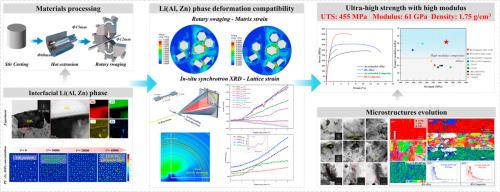Achieving superior strength in high modulus Mg-Li matrix composites via rotary swaging with interfacial precipitation-induced strain compatibility
IF 12.8
1区 材料科学
Q1 ENGINEERING, MECHANICAL
引用次数: 0
Abstract
The inherently low Young’s modulus and limited strength of Mg-Li alloys have long restricted their structural application potential. In this study, we developed a modulus-oriented TiB2/LAZ532 composite via rotary swaging, integrating particle reinforcement, severe plastic deformation, and interface engineering. Rotary swaging refined the grain structure to the submicron scale and introduced a high density of dislocation substructures, thereby enabling substantial strength improvement. Meanwhile, Li(Al, Zn) precipitates were observed to form at TiB2/matrix interfaces, as confirmed by TEM, phase-field simulations, FEA, and in-situ synchrotron XRD. These interfacial precipitates acted as middle layer reducing stress concentration and enhancing strain transfer across particle/matrix boundaries, thus achieving improved deformation compatibility. Owing to the dual contribution of matrix grain refinement/dislocation hardening and interfacial strain accommodation, the composite achieved an ultimate tensile strength of 455 MPa, Young’s modulus of 61 GPa, and a low density of 1.75 g/cm3. This unique combination of ultra-light weight and mechanical robustness highlights a functionally partitioned strengthening strategy, wherein reinforcement, processing, and interface design contribute complementary roles. The approach provides a generalizable pathway for designing next-generation lightweight Mg-Li structural materials.

通过界面析出诱导应变相容性的旋转挤压,获得高模量Mg-Li基复合材料的优越强度
Mg-Li合金固有的低杨氏模量和有限强度长期制约着其结构应用潜力。在这项研究中,我们通过旋转模压,整合颗粒增强,剧烈塑性变形和界面工程,开发了面向模量的TiB2/LAZ532复合材料。旋转挤压将晶粒组织细化到亚微米级,并引入高密度的位错亚结构,从而大大提高了强度。同时,通过TEM、相场模拟、有限元分析和原位同步加速器XRD等手段证实,在TiB2/基体界面处有Li(Al, Zn)析出。这些界面析出物起到中间层的作用,降低了应力集中,增强了颗粒/基体边界上的应变传递,从而提高了变形相容性。由于基体晶粒细化/位错硬化和界面应变调节的双重作用,复合材料的极限抗拉强度为455 MPa,杨氏模量为61 GPa,低密度为1.75 g/cm3。这种独特的超轻重量和机械坚固性的结合突出了功能分区的强化策略,其中加固,处理和界面设计贡献互补的作用。该方法为下一代轻量化镁锂结构材料的设计提供了可推广的途径。
本文章由计算机程序翻译,如有差异,请以英文原文为准。
求助全文
约1分钟内获得全文
求助全文
来源期刊

International Journal of Plasticity
工程技术-材料科学:综合
CiteScore
15.30
自引率
26.50%
发文量
256
审稿时长
46 days
期刊介绍:
International Journal of Plasticity aims to present original research encompassing all facets of plastic deformation, damage, and fracture behavior in both isotropic and anisotropic solids. This includes exploring the thermodynamics of plasticity and fracture, continuum theory, and macroscopic as well as microscopic phenomena.
Topics of interest span the plastic behavior of single crystals and polycrystalline metals, ceramics, rocks, soils, composites, nanocrystalline and microelectronics materials, shape memory alloys, ferroelectric ceramics, thin films, and polymers. Additionally, the journal covers plasticity aspects of failure and fracture mechanics. Contributions involving significant experimental, numerical, or theoretical advancements that enhance the understanding of the plastic behavior of solids are particularly valued. Papers addressing the modeling of finite nonlinear elastic deformation, bearing similarities to the modeling of plastic deformation, are also welcomed.
 求助内容:
求助内容: 应助结果提醒方式:
应助结果提醒方式:


